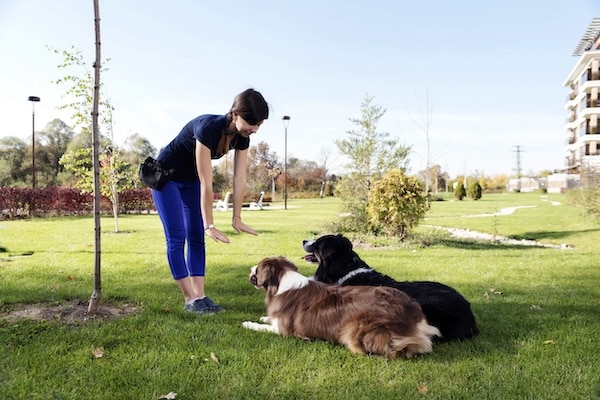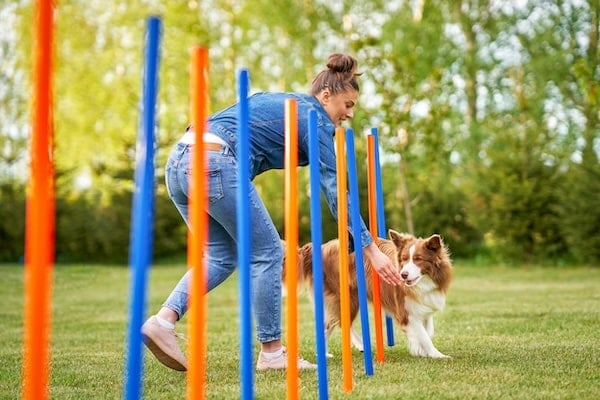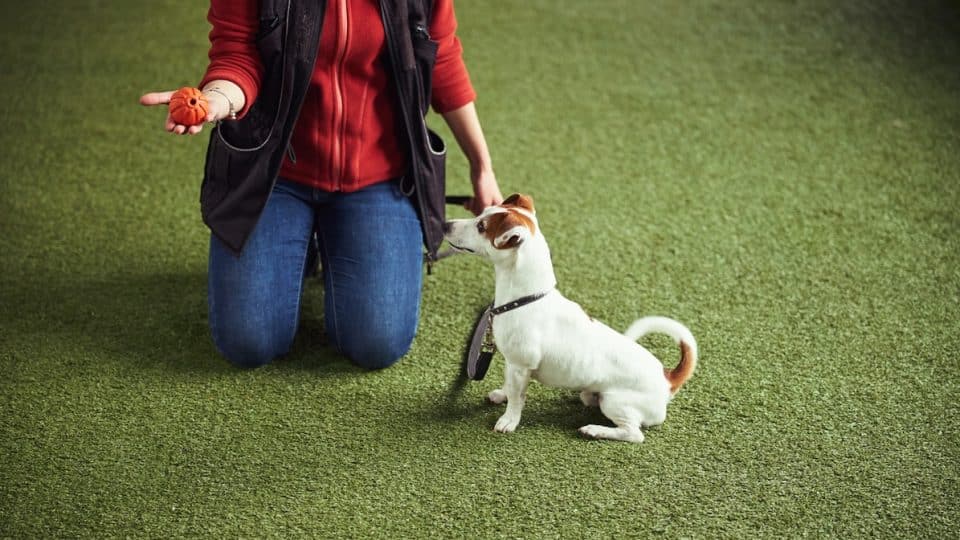- Not a substitute for professional veterinary help.
Training a dog can be incredibly rewarding—but it can also leave you wondering when you’ll see results. How long does it take to train a dog?
According to Alexandra Bassett, lead dog trainer and behavior consultant at Dog Savvy, basic obedience typically requires about 1 to 2 months of dedicated training, while intermediate skills may take 4 to 6 months to master. More advanced training can extend to 6 months or even a year.
These timelines will vary based on a dog’s age, background, and the consistency of training. In this guide, we’ll explore key dog training milestones, outlining what you can realistically expect at different stages. We’ll also provide practical tips for speeding up the process, with input from two professional dog trainers.
What Does “Fully Trained” Look Like?
“Fully trained” can mean different things to different people, shaped by individual expectations and lifestyles. For some, a dog that no longer has accidents indoors is considered fully trained. Others might need their dog to remain composed and responsive in high-stress situations.
For clarification, Bassett breaks down what dogs should be capable of at each training level.
Basic training (1-2 months)
Basic training lays the foundation for obedience and good behavior. A dog at this stage should be able to:
- Respond to basic cues, including essentials like sit, down, stay, come, and paw.
- Display good manners, behaving appropriately at home and in public (e.g., not jumping on people or begging for food).
Intermediate training (4-6 months)
After mastering the basics, dogs can progress to intermediate training. This builds on foundational skills and introduces more involved tasks. At this stage, a dog should be capable of:
- Loose leash walking, which means walking next to their handler without pulling.
- Reliable recall, or returning when called, even with distractions.
- Maintaining focus, which means staying responsive in stimulating environments like crowded parks or busy streets.
Advanced training (6 months – 1 year)
Advanced training takes skills to the next level. A dog ready for more complex training can practice:
- Off-leash control, which means following commands without the need for restraint.
- Distance commands, or responding to cues given from a distance.
- Advanced tricks and activities, which might include agility training, nosework, or even using buttons for communication.
- Phasing out treats.
Remember, training is an ongoing journey rather than a destination. As expert trainer Shoshi Parks points out, learning continues throughout a dog’s life. Even after reaching an advanced training level, it’s important to reinforce good behavior with intermittent rewards, which helps maintain skills and prevent regression.

payamona via iStock
Tips for Speeding Up Training
The time it takes to train a dog varies, but there are ways to maintain steady progress—and even accelerate the process.
Parks lays out some effective tips to expedite training.
- Get everyone on board. Everyone in the household should understand and agree on the training goals. When everyone responds the same way to a dog’s behavior, it becomes easier to reinforce positive actions and avoid rewarding unwanted ones.
- Be consistent. Consistency establishes clear expectations for your pet. When you reliably reward good behavior and don’t encourage negative behavior, your dog learns more quickly what you want—and what you don’t.
- Use high-value rewards. The better the rewards, the more motivated your dog will be to learn, explains Parks. For big wins or hard skills, offer small pieces of hotdog, chicken, or cheese.
- Keep training sessions short and sweet. Short, focused training sessions help maintain your dog’s attention and prevent frustration. This leads to better retention and faster progress.
How much training should you do each day?
According to Bassett, pet parents should aim for the following daily practice times to reach each training tier.
- Basic: 10-15 minutes, 2-3 times per day
- Intermediate: 15-20 minutes, 2-3 times per day
- Advanced: 20-30 minutes daily (plus regular reinforcement during everyday activities)
To speed up the process, Bassett suggests increasing the number of daily training sessions. It’s still important to keep sessions short to maintain focus and prevent boredom. Additionally, you can incorporate training into your daily routines, such as practicing “stay” while preparing meals or “heel” during walks.
Timeline for Basic Obedience
| Skill | Time to Train |
| Sit | 1-2 weeks |
| Down | 1-2 weeks |
| Stay | 2-4 weeks for short stays; up to 2 months for longer stays |
| Drop It | Up to 4 weeks |
| Loose Leash Walking | 1-3 months |
Bassett lays out a typical timeline for mastering some fundamental basics.
- Sit: This cue usually takes about 1-2 weeks of consistent practice.
- Down: Like sit, this basic cue usually takes 1-2 weeks.
- Stay: This can take anywhere from 2-4 weeks for short stays (just a few seconds). Longer stays (a few minutes or more) may take up to 2 months, depending on the dog’s focus and patience.
- Drop It: Typically, it takes 1-2 weeks for dogs to grasp a basic understanding of “drop it.” For dogs with a strong possessive instinct, Bassett says it can take up to 4 weeks.
- Loose Leash Walking: This skill often requires more time, typically 1-3 months. The outcome largely depends on the frequency of practice and the dog’s enthusiasm during walks and outdoor activities.
Timeline for House Skills
| Skill | Time to Train |
| Potty training | 3-6 months |
| Crate training | 1-3 months |
| Crate-free alone time | 6-12 months |
For a peaceful home, all dogs need to learn a few fundamental skills. Bassett walks us through a typical timeline for some essentials:
- Potty training: Most puppies become fully potty-trained within 4 to 6 months. Fast learners may pick it up in as short as 3 months, while others, especially smaller breeds or adult dogs, might take a bit longer.
- Crate training: Initial crate training can be accomplished in 1 to 2 weeks. However, Bassett says it can take 1 to 3 months for a dog to be fully comfortable and see the crate as their safe space. If you’re crate-training an adult dog, it could take longer.
- Leaving a dog home alone without a crate: Most dogs can handle crate-free alone time after 6-12 months. Bassett emphasizes that this timeline depends on the dog’s ability to stay calm and avoid destructive behavior while alone. “Gradual progression is key,” she says.

macniak via iStock
Timeline for Advanced Skills
| Skill | Time to Train |
|---|---|
| Phasing out treats | 2-3 months |
| Distance obedience | 4-6 months |
| Nosework | 3-4 months |
| Agility | Up to two years for full proficiency |
| Speech buttons | 3-6 months |
Training a dog in advanced skills requires patience and consistency. Bassett offers a general timeline for some key areas.
- Phasing out treats: Once your dog has learned commands with treats, expect to spend about 2 to 3 months gradually phasing them out. Bassett recommends replacing treats with praise, toys, or an enjoyable activity, like a sniff-filled decompression walk.
- Distance obedience: Achieving reliable distance obedience (where your dog responds to cues when a distance apart from their handler) can take 4 to 6 months.
- Nosework: How long it takes to teach a dog nosework can depend on their natural aptitude and enthusiasm. If your goal is to master all the scents in a scent kit, indoor and out, four months is a reasonable goal.
- Agility training: Becoming proficient in advanced agility courses generally requires a commitment of about two years. Progress depends on a dog’s physical fitness, drive, and focus.
- Speech buttons: How long it takes to train speech buttons depends on how many buttons you want to teach. Three weeks per button is a common goal, though the difficulty of the word or phrase will impact your timeline.
Timeline for Behavior Challenges
| Problem Behavior | Time to Train |
| Bite inhibition | 4-6 months |
| Chewing | 6-12 months |
| Reactivity | 6 months – 1 year |
| Separation anxiety | 3-6 months |
| Aggression | From several months to years |
You’ll need extra patience for dogs who’ve picked up some challenging habits. As Parks explains, improving fear- or anxiety-based behaviors through training is a long-term commitment.
According to Bassett, the time it takes to resolve behavioral issues varies based on the dog’s age, temperament, and the consistency of training. Here are some general timelines for common issues.
- Bite inhibition: Most puppies learn bite inhibition by 4 to 6 months, though some may need reinforcement into adulthood.
- Chewing: It can take 6-12 months to stop inappropriate chewing.
- Reactivity: Depending on the severity of the behavior and the training methods used, it may take anywhere from 6 months to over a year to address reactivity.
- Separation anxiety: This common issue often takes between 3 and 6 months to resolve.
- Aggression: Managing aggressive behavior can take several months to years, and working with a professional behaviorist or trainer is often necessary.

Tetiana Garkusha via iStock
What Makes Training Take Longer?
A number of factors can prolong or shorten the training process. Understanding these factors can helps you tailor your approach for better results.
Age
Generally, puppies learn faster than older dogs because they are more adaptable and open to change. Adult dogs, on the other hand, may take longer to unlearn bad habits.
It’s important to tailor training to your dog’s developmental stage. For example, puppies under three months cannot hold their bladders for long, which should be considered when developing training routines.
A dog’s breed & temperament
Certain breeds, particularly working and herding dogs, often grasp new cues quickly. However, Bassett points out they can also require more mental stimulation to stay focused during training sessions.
Personality also plays a role. Calm and focused dogs usually learn faster than highly excitable or anxious ones.
Dog history
Past negative experiences can prolong the training process. According to Bassett, dogs with a history of trauma or neglect may need more time to trust and learn new behaviors.
Parks adds that dogs who’ve experienced aversive training techniques often carry a fear of learning. “They may be unwilling to follow lures because they fear what will happen if they get it wrong,” she says. “They may be startled by marker words or clickers because sharp noises once predicted punishment.”
Whether a dog is food-motivated
Highly food-motivated dogs often respond better to training, as treats are an effective reinforcement tool. Conversely, dogs who are indifferent to food may require alternate strategies to engage their interest in learning.
How much training can be done each day
Inconsistent training can confuse a dog and hinder progress. Regular training sessions are a must if you want to see steady progress.
“As a trainer, I may be able to teach your dog to sit, down, stay, and basic recall within a couple of weeks,” Parks notes. “But if you aren’t consistently reinforcing those skills, they’ll remain spotty and underdeveloped.”
Pet parent experience
Unsurprisingly, experienced handlers often see faster results than first-time dog owners. It takes time and practice to learn timing, technique, and body language for effective training. The good news, though, is that you’ll learn as your dog does, especially if you stay curious and patient.
Don’t be discouraged if your dog’s training progress doesn’t match these timelines. As Parks reminds us, every dog learns at their own pace. While factors like breed type and age play a role, it really comes down to the individual dog. Some dogs just need more time for things to stick.
Training can be tough. If you’re really stuck, we recommend working with a professional trainer. Good luck!




